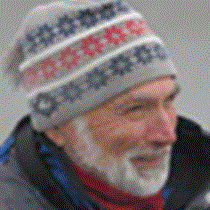Glacier Bay National Park
The water was calm and its glassy surface reflected the gray from above. Jagged mountain tops were from a postcard dream as we gazed upon a scene with no horizon. This is not an unusual start for a trip into Glacier Bay. Soon the fog would burn off, and the beautiful surroundings would slowly appear draped in thin cotton.
The Marble Islands are the summer home for sea birds and northern sea lions. Their location is surrounded by productive waters and enough isolation to make it a perfect place for throngs of black- legged kittiwakes, glaucous-winged gulls and a pair of herring gulls. Tufted puffins with their bright yellow head plumes were also abundant in the air and water close to our ship. A pair of horned puffins passed by as well. At times, sub-adult bald eagles flew in close to the cliffs and sent kittiwakes into the air. Breeding pelagic cormorants, oystercatchers and pigeon guillemots were there too, but the most conspicuous residents were the northern sea lions. Although endangered in the Gulf of Alaska, this population is doing well. They were here by the hundreds, scattered over most of the bare rocks near the water’s edge. Their low-pitched growls and the calls of kittiwakes added to the experience.
Our National Park Ranger for the day was Janeen Driscoll, a very experienced naturalist. After the Marble Island visit, she gave us an introduction to the park, how our day would unfold and words of wisdom to connect the experience with our daily lives.
Gloomy Knob is a gray dolomite outcrop with sheer cliffs that plummet into the sea. It looks most inhospitable to anything but a mountain goat. We first saw a yearling and then a nanny with a kid on a grassy ledge. Their precarious home discourages less nimble footed bears, and although wolves might be able to reach them, an effective kill would be more risky for the wolf than the goat.
On our way to Russell Cut we watched a brown bear nearly walk into a camp with three people in it. All four of them made the right decisions. The campers brought their equipment to a central point and gathered as the bear noticed them and calmly moved into the trees. The bear didn’t want their company either. Later we watched another large beautiful brown bear walk along a glacial outwash plain and begin to graze within a strand of willows.
Margerie Glacier is a huge and beautiful stream of ice that slowly pours down and out of the Fairweather Range. On the opposite side of these mountains is the Pacific Ocean where the northward moving Pacific Plate first encounters Alaska. For many millions of years it has been making an attempt to push this great state of Alaska out of the away. As this struggle has continued, the massive plate has lifted the Fairweather Range upward a mere 15,300 ft. It has actually been pushed far more, but the erosive force of ice has kept up with uplift tearing down the work of the plate. We looked upon one of these great levelers called Margerie Glacier.
One memorable stop on our return was for a dead humpback whale. It died sometime in early spring and was now a huge, pale-yellowish blob. Two lower jaw bones stuck out at odd angles, and the throat pleats ran 2/3 the length of the body. Two brown bears were in the area, no doubt seeking a rotting snack.
As we consumed our dinner, the ship pulled into Bartlett Cove, and the crew tied us to the dock. Some of us headed out on a hike through the forest, while others made their way to the lodge. We all felt the need for exercise as the day came to a close.




